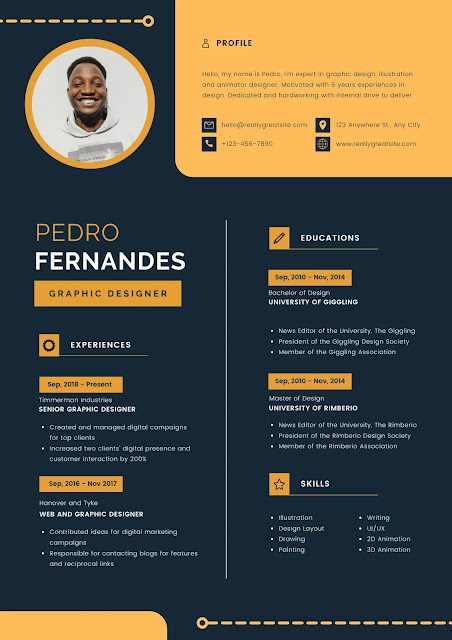In the dynamic realm of
graphic design, a meticulously crafted resume can serve as your golden ticket
to securing that coveted dream job. Your resume represents more than a mere
compilation of experiences; it's a canvas that displays your aptitudes and imaginative
flair. This guide will navigate you through the process of fashioning an
exceptional graphic designer resume, one that effortlessly captures the
attention of prospective employers.
v
1. The Essentials: Contact Information and
a Compelling Introduction
Commence your resume
with essential details: your full name, contact number, email address, and
location. Sequel this with a succinct yet impactful introduction. This segment
should encapsulate your identity as a designer, spotlighting your distinctiveness.
Feel free to infuse a touch of your personal essence, leaving a lasting
imprint.
v
2. Spotlight on Your Skill Set
Devote a dedicated
section to showcase your proficiencies. Encompass both technical competencies
(such as mastery in Adobe Creative Suite, typography, and color theory) and
soft skills (including innovation, communication, and problem-solving). Employ
bullet points to ensure clarity and ease of perusal.
v
3. Exemplify Your Professional Trajectory
When delineating your
work history, focus on pertinence. Spotlight roles and projects that harmonize
with the domain of graphic design. For each position, provide the company's
name, your designation, tenure, and a succinct portrayal of your
responsibilities. Emphasize accomplishments over mere task enumeration.
Whenever feasible, quantify achievements – cite the quantity of designs
conceived, successful projects completed, or clients you've collaborated with.
v
4. A Window to Your Portfolio
Contemplate integrating
a dedicated section to present a curated assortment of your most remarkable
design projects. Encompass a diverse array of creations to underscore your
versatility. Additionally, the inclusion of a QR code linked to your online
portfolio could offer a distinctive touch, enabling employers to delve deeper
into your work.
v
5. Educational Journey and Training
Enumerate your
educational trajectory, encompassing pertinent degrees, certifications, and
workshops. If you're a recent graduate, accentuate design-centric coursework,
accolades, or honors. Conversely, if your professional journey spans several
years, your employment history and portfolio might eclipse the educational
segment.
v
6. Strategic Keywords and Tailoring
Numerous companies
leverage Applicant Tracking Systems (ATS) to sift through resumes for specific
keywords. Thoroughly investigate job descriptions within your domain and weave
relevant keywords into your resume. Furthermore, customize your resume for each
application, accentuating skills and experiences aligning with the specific
role.
v
7. Aesthetic and Structure
Remember, your resume
reflects your design acumen. Opt for an uncluttered, professional layout that
facilitates readability. Maintain uniformity in fonts and formatting throughout
the document. Infuse subtle visual elements such as borders or icons for a dash
of creativity. However, ensure that these enhancements complement rather than
overshadow the content.
v
8. Thorough Proofreading
Exhaustive proofreading
is paramount. Errors can erode the veneer of professionalism. After conducting
a self-review of your resume, seek assistance from a friend or colleague to
conduct a final sweep for grammatical accuracy, spelling precision, and overall
clarity.
v 9. Contact
Details and an Inviting CTA
Conclude your resume
with a clear call to action. Encourage potential employers to initiate contact
for further discourse or an interview. Reinstate your contact number and email
address to facilitate seamless communication.
v Conclusion
The process of
sculpting the perfect graphic designer resume entails harmonizing your artistic
prowess with a professional demeanor. Your resume serves as a visual narrative
of your journey as a designer, spotlighting your competencies, experiences, and
triumphs. Strive for brevity, aesthetic allure, and alignment with the job you
aspire to secure. Remember, your resume is your inaugural interaction with
potential employers – endeavor to make it resound and distinguish yourself in a
sea of applicants.




0 Comments